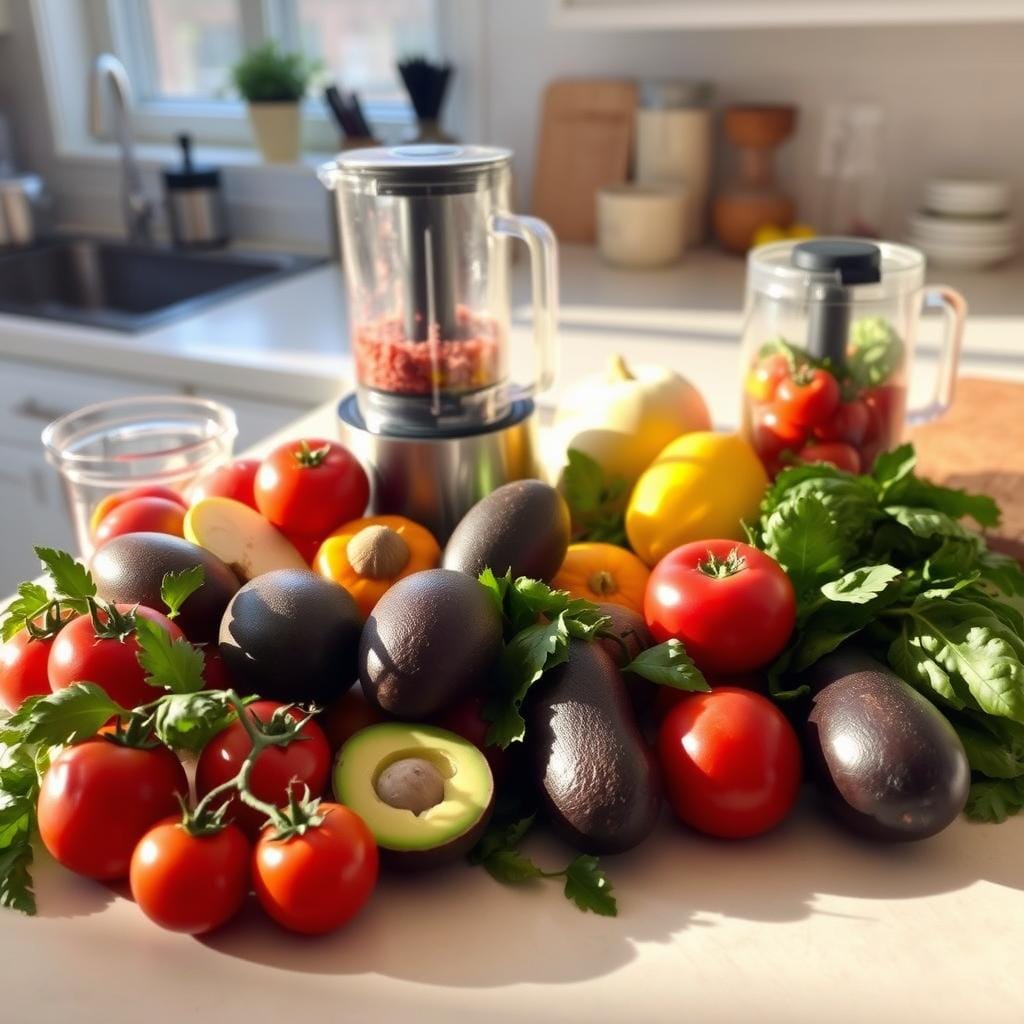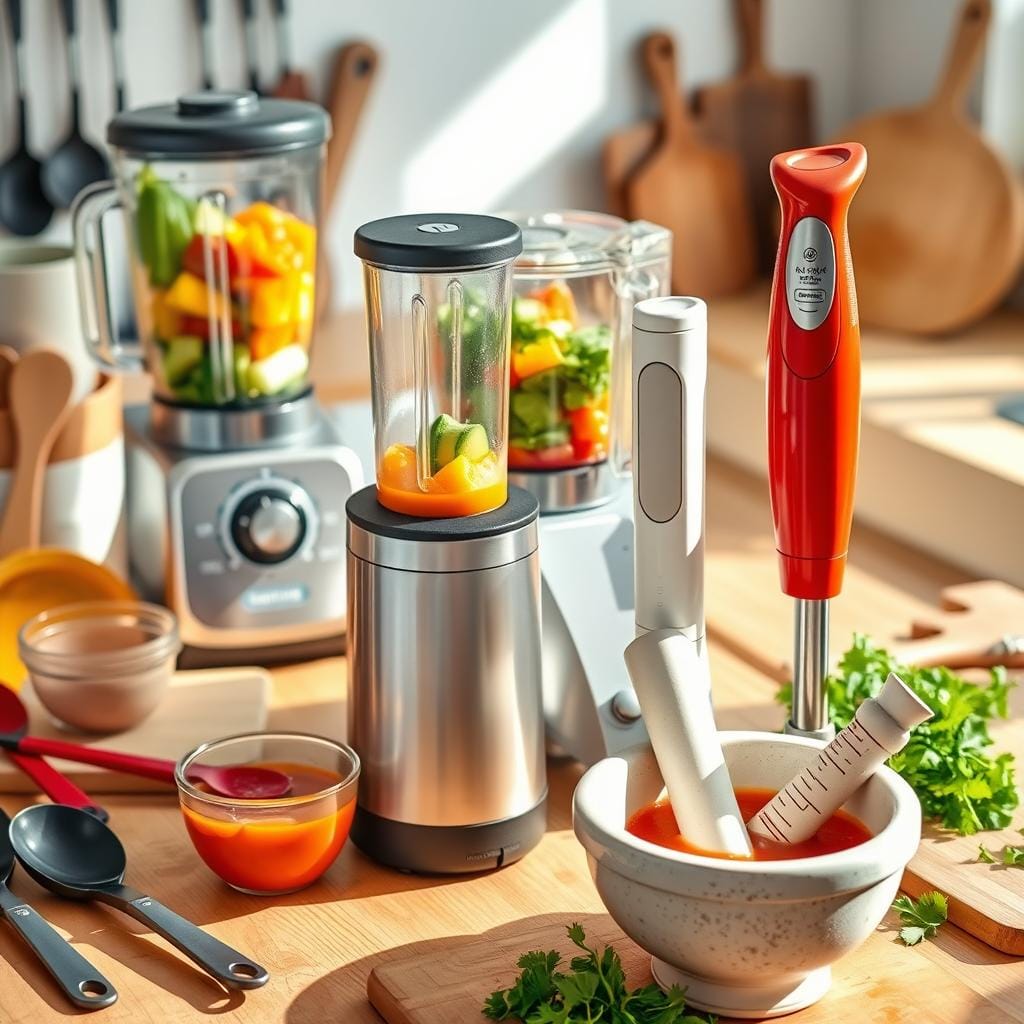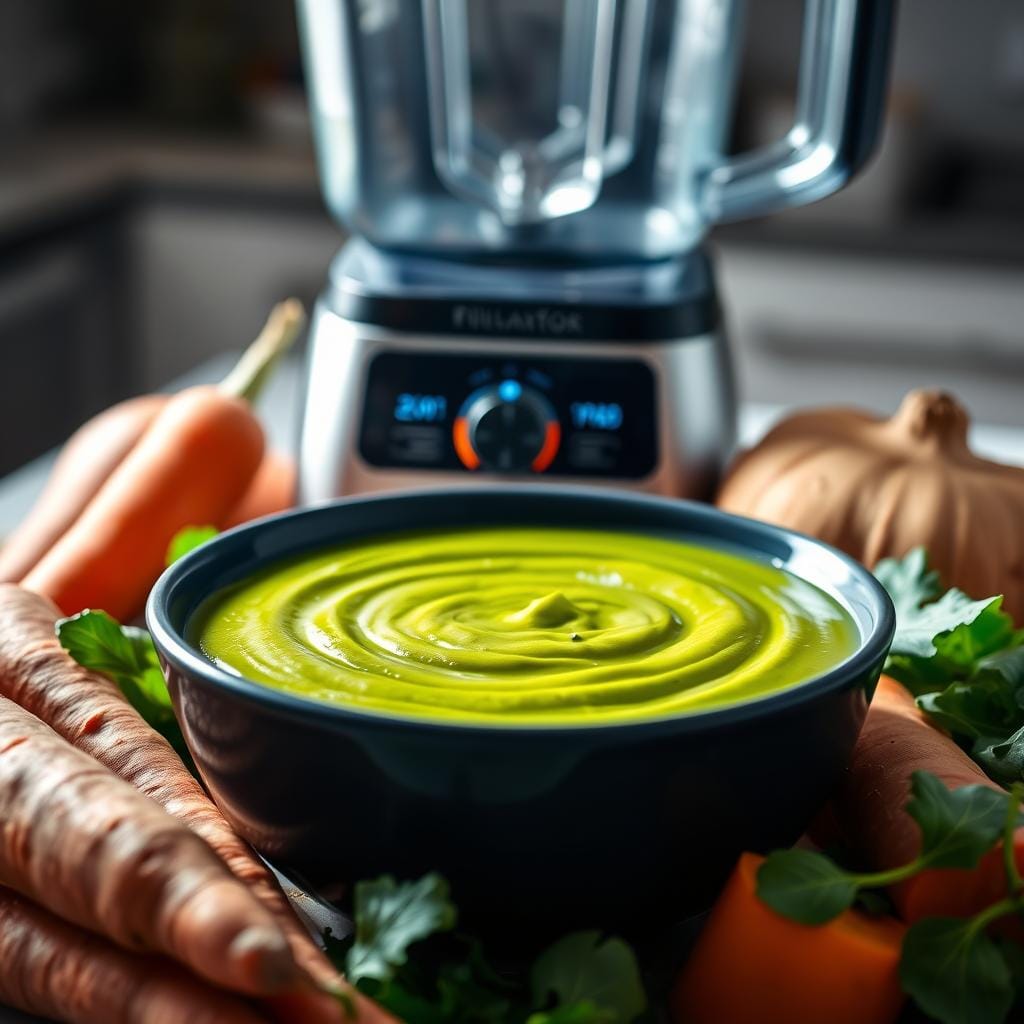How do you make a puree? Ever wondered how chefs create such smooth, perfect purees? I’ve been exploring this myself and am excited to share what I’ve learned.
Making purees might seem easy, but it’s an art that can make your dishes stand out. Whether it’s a creamy soup, a colorful veggie side, or baby food, the right techniques can turn simple ingredients into something amazing.

Key Takeaways
- Discover the fundamentals of pureeing for smooth, consistent results
- Learn about the essential equipment and tools for perfect purees
- Explore tips for selecting and preparing the best ingredients for pureeing
- Uncover common mistakes to avoid and how to troubleshoot texture issues
- Dive into the versatility of purees and their various uses in the kitchen
Understanding the Art of Pureeing: A Beginner’s Guide
Pureeing turns solid ingredients into a smooth, creamy mix. It’s great for making dishes like soups and desserts better. Whether you’re new to cooking or experienced, learning pureeing can expand your culinary skills.
Pureeing means blending ingredients into a smooth puree consistency. You can use tools like food processors, blenders, or even manual tools. Knowing the right techniques and tools is key to making the perfect puree uses.
Pureeing brings out and blends flavors well. It breaks down ingredients to release oils, sugars, and aromas. This makes sauces, soups, and desserts silky and rich.
“Pureeing is the secret to unlocking the true essence of your ingredients, transforming them into a symphony of flavors.”
Pureeing also changes how ingredients feel and look. You can make purees smooth or slightly chunky. This lets you use purees in many ways, from baby food to fancy garnishes.

Learning to puree is essential for making things like hummus or chocolate mousse. It’s a skill that lets you create many dishes. With pureeing, you can turn blending ingredients and puree consistency into your own creations.
Essential Equipment and Tools for Perfect Purees
Making a smooth puree is an art. The right tools in your kitchen can make a big difference. You’ll need everything from high-powered blenders to manual devices.
Food Processors vs. Blenders
Food processors and blenders have their own strengths. Processors are great for chopping and pureeing solid foods, giving a coarser texture. Blenders, on the other hand, make silky-smooth purees, breaking down tough veggies and fruits easily.
Manual Pureeing Tools
- Potato Masher: A simple tool for mashing soft foods like potatoes and squash.
- Ricer: Forces food through holes for a fluffy texture, perfect for mashed potatoes.
- Immersion Blender: A versatile tool for pureeing sauces and small batches right in pots.
Strainers and Sieves
Strainers and sieves are key for a smooth puree. They remove lumps, making the puree silky. Choose from fine-mesh strainers to chinois sieves to get the best results.

“The right tools can make all the difference in creating a perfectly smooth and creamy puree.”
How Do You Make a Puree?
Making a puree is a skill that can make your dishes better. It’s great for smooth soups, creamy dips, or baby food. Learning to puree is a big plus in the kitchen.
To make a puree, follow these steps:
- Select your ingredients: Pick fresh, quality ingredients like fruits, veggies, grains, or legumes.
- Prepare the ingredients: Wash, peel, and chop them into small pieces for blending.
- Blend or process: Use a food processor, blender, or immersion blender until smooth.
- Adjust the texture: Add liquid to thin out a thick puree. Blend more for a thinner one.
- Season and taste: Add salt, spices, or herbs to taste. Adjust as needed.
These steps help you make tasty purees for soups, sauces, and dips. Try different ingredients and methods to create your own recipes.
| Ingredient | Quantity | Blending Time |
|---|---|---|
| Carrots | 2 cups, peeled and chopped | 2-3 minutes |
| Spinach | 1 cup, washed and stems removed | 1-2 minutes |
| Chickpeas | 1 (15 oz) can, drained and rinsed | 3-4 minutes |
Creating a perfect puree takes patience and practice. Keep trying until you get it right. Soon, you’ll make purees that wow everyone.
Selecting and Preparing Ingredients for Pureeing
Making tasty purees starts with picking the right ingredients. Whether it’s for a puree recipe for baby food or a fruit puree for a smoothie, the quality matters a lot. Here are key tips for choosing and preparing your ingredients for a healthy puree full of flavor and nutrients.
Choosing Fresh Produce
The base of any great puree is fresh, ripe produce. Choose fruits and vegetables that are in-season and ripe. This means they’ll taste better and be more nutritious. Stay away from any produce that’s damaged or showing signs of spoilage.
Proper Washing and Cleaning
- Thoroughly rinse all produce under cool running water to remove any dirt, debris, or residues.
- Use a vegetable brush to gently scrub the surface of harder fruits and vegetables, like carrots or apples.
- Pat the produce dry with a clean, lint-free towel or paper towels to ensure excess moisture is removed before pureeing.
Pre-cooking Methods
Some produce benefits from a bit of pre-cooking. Steaming or sautéing vegetables like sweet potatoes or squash can make them softer and sweeter. For fruits, a quick poach or roast can make them taste richer and more flavorful.
| Ingredient | Recommended Pre-cooking Method |
|---|---|
| Carrots | Steam for 5-7 minutes until tender |
| Apples | Peel, core, and roast at 375°F for 15-20 minutes |
| Spinach | Sauté in a bit of olive oil until wilted |
By carefully choosing and preparing your ingredients, you’re on your way to making puree recipes that are both healthy and delicious. Follow these tips to create smooth, tasty purees.
Basic Techniques for Smooth and Consistent Results
Getting the perfect puree texture is all about mastering a few key techniques. Whether you’re making a smooth soup or baby food, blending, straining, and adjusting consistency are crucial. Let’s dive into the essential steps for smooth and flawless purees.
Start by focusing on your blending method. Proper pureeing techniques mean slowly increasing your blender’s speed. This lets the ingredients break down smoothly. But, don’t overdo it, as it can make your puree gritty.
After blending, strain your puree through a fine mesh sieve or chinois. This step removes any lumps or fibrous bits. It ensures your puree is silky-smooth and pleases the taste buds.
Lastly, adjust the puree’s consistency as needed. You can add liquid like broth or milk to make it smoother. If it’s too thin, add a bit of cornstarch or potato starch to thicken it.
By learning these basic pureeing techniques, you’ll make smooth and creamy purees. These will take your cooking to the next level. So, get creative, practice, and enjoy the tasty outcomes!
Common Mistakes to Avoid When Making Purees
Making the perfect puree needs skill and focus. Even experienced chefs can make mistakes. Knowing how to avoid these issues is key to a smooth process.
Texture Problems
Texture issues are a big problem in purees. You might get a grainy or watery result. To fix this, check your ingredients and how you prepare them. Using the right tools and blending in batches helps a lot.
Temperature Considerations
Temperature is very important for purees. If ingredients are too hot or cold, it can ruin the texture and taste. Make sure your ingredients are at the right temperature before blending.
Storage Errors
Storing purees correctly is crucial. Don’t use the wrong containers or freeze them wrong. Learn the best ways to store them to keep your purees fresh.
By watching out for these common mistakes, you can make purees that are smooth and flavorful. Pureeing is a skill that takes time to learn, but it’s worth it.
Different Types of Purees and Their Uses
Purees are versatile and can be used in many ways. They range from savory to sweet, fitting every taste and diet. They can make soups and sauces creamy or create tasty desserts. Knowing the different types of purees and their uses can unlock many culinary doors.
Vegetable Purees
Vegetable purees, like carrots, sweet potatoes, or butternut squash, add richness and flavor. They’re great as a base for soups, stews, or even as a spread for toast or crackers.
Fruit Purees
Fruit purees, such as apple, mango, or berry purees, are great for both sweet and savory dishes. They’re perfect in yogurt, smoothies, or as a topping for pancakes and waffles. They also enhance baked goods like muffins and cakes.
Protein-Based Purees
Protein-rich purees, like those from beans, lentils, or chickpeas, boost nutrition and texture. They’re excellent for dips and spreads, or in veggie burgers or meatloaf.
Every type of puree can improve flavor and texture in many dishes. Try using fruit purees in desserts and healthy purees in savory meals. Discover the endless possibilities purees offer.
Creating Baby Food Purees: Safety and Nutrition
Making baby food purees is all about safety and picking the right ingredients. As you start your baby’s food journey, here are key tips. They ensure your baby’s meals are tasty and healthy.
Age-appropriate Ingredients
Choosing the right ingredients is vital for your baby’s meals. Begin with simple foods like sweet potatoes, carrots, or applesauce. As your baby grows, add more flavors and textures. Always check with your pediatrician to make sure you’re giving the best food for your baby’s growth.
Storage Guidelines
Storing baby food purees correctly is important. Use airtight containers or freezer bags and label them. Keep fresh purees in the fridge for 3 days and frozen ones for 3 months. Always thaw frozen purees in the fridge before serving.
Portion Control
Finding the right portion sizes is crucial for your baby’s meals. Start with 2-4 tablespoons of puree per serving. Adjust based on your baby’s age, appetite, and how they seem to be doing. Increase the amount as your baby gets bigger and hungrier.
By following these guidelines, you can make baby food purees, healthy purees, and puree recipes safely and healthily. Enjoy making homemade baby food and watch your child’s food adventures grow with each delicious bite.
Advanced Pureeing Tips for Professional Results
Take your pureeing skills to the next level with techniques from professional chefs. Learn how to make smooth, tasty purees that will wow your guests. These advanced tips will help you get restaurant-quality results at home.
To make a silky-smooth puree, cook the veggies well before blending. Fully cooked veggies blend better, making the puree creamier. Let them get a bit caramelized for more flavor.
- Try different cooking methods like roasting, simmering, or steaming for unique tastes and textures.
- For an extra-velvety texture, strain the cooked veggies through a fine-mesh sieve before blending.
- Add richness by stirring in butter or high-quality olive oil before pureeing.
Get creative with presentation. Layer different purees for visual appeal and contrasting flavors. Add fresh herbs, toasted nuts, or crème fraîche for a fancy touch.
| Puree Technique | Desired Texture | Best Vegetables |
|---|---|---|
| Roasting | Smooth and creamy | Carrots, butternut squash, sweet potatoes |
| Simmering | Silky and velvety | Cauliflower, parsnips, peas |
| Steaming | Light and airy | Broccoli, asparagus, spinach |
For top-notch purees, be patient and pay attention to detail. With practice and these tips, you’ll soon be making amazing dishes at home.
“The secret to making a great puree is all in the preparation. Cooking the vegetables properly and removing any tough fibers are essential for a silky-smooth texture.”
Storing and Preserving Your Purees
Learning to puree is just the start. Storing and preserving your purees right is key to keeping their taste, texture, and nutrients. Whether you’re making a puree recipe for a snack or fruit purees for baby food, these tips will help you store them well.
Freezing Methods
Freezing is a top way to keep your healthy purees fresh for a long time. Here are some freezing methods to try:
- Portioning and Flash Freezing: Split your puree into servings, then freeze them on a baking sheet until solid. This stops clumps in the freezer.
- Ice Cube Trays: Fill trays with puree, freeze, then pop out cubes and store in a bag or container.
- Vacuum Sealing: Seal your puree in bags or containers with a vacuum sealer to keep air out and freshness in.
Container Selection
The right containers are crucial for keeping your puree recipe fresh. Here are some good options:
- Glass jars or airtight containers: They seal well to prevent air and freezer burn.
- Freezer-safe plastic bags or pouches: Choose durable ones for freezer storage.
- Silicone trays or molds: Flexible and portioned, they’re easy to use.
Shelf Life Guidelines
Storing your purees right can extend their life. Here are some general guidelines:
| Storage Condition | Shelf Life |
|---|---|
| Refrigerator (40°F or below) | 3-5 days |
| Freezer (0°F or below) | 6-8 months |
These are just estimates. The actual shelf life can vary. Always check your purees for spoilage before eating.
“Proper storage and preservation are the keys to enjoying the full flavor and nutritional benefits of your homemade purees for weeks or even months to come.”
Conclusion
In this guide, you’ve learned about pureeing. You now know the key tools and techniques for making smooth purees. Whether you cook at home or are a professional chef, you have a solid base to explore pureeing techniques.
Purees can be anything from vibrant vegetable to silky fruit compotes. With fresh ingredients and the right techniques, you can make simple dishes into works of art. Try new flavors and textures to find your own puree creations.
Keep exploring pureeing and let your creativity flow. Learning to puree opens up many culinary doors. It also helps you make healthy, tasty dishes that please everyone. Start your pureeing adventure and watch your cooking skills grow.

